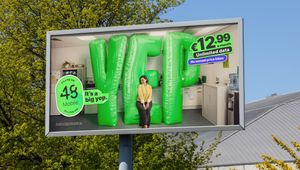
The Flanderisation of ‘Weird Ads’

Weirdness is like silence, if you say it out loud, it disappears.
If I had a euro for every time I heard the word ‘weird’ used as a catch-all descriptor for an advert or piece of media, I would personally be able to pay Oxford Dictionary to wipe the word ‘weird’ from the English language, and free us from the vocabulary vice that it has clamped upon us.
Over the last two decades the role of ‘weirdness’ in advertising has fundamentally changed. I’m of the belief that weirdness is at its best in advertising when it’s a side-effect of good work, rather than a fundamental ingredient in its creation.
Weirdness should be a bonus, not a goal.
Weirdness seems to have devolved into a target for what some marketing campaigns should be, it is no longer just another descriptor but instead the driving force behind decisions towards ‘the future of advertising’. It has fallen victim to Flanderisation.
‘Flanderisation’ has gained popularity as a criticism of writing tropes in media and film, and is defined as 'The progressive exaggeration of a single trait or set of traits of a fictional character until it overtakes all other characterisation.'
The default example of this is of course the titular Ned Flanders, who over the many years of The Simpsons, has morphed from a stereotypical perfect neighbour, into a one-dimensional devout Christian. Originally intended to be the polar opposite of Homer, who represents all things good and pure, but through years of simplification of some details and exaggerations of others, has become a parody of himself. Other examples include Joey Tribiani from Friends, shifting from a slightly dim but very charming individual to a dangerously stupid, almost non-functional character, and DC villain Harley Quinn, who descended from a tragic origin with psychiatric and emotional struggles, to ‘Crazy Crazy Crazy!’
Before you close your tab and ask yourself 'I thought this was meant to be about advertising?', allow me to seamlessly segue into how this term applies to what a weird ad is, and let us step into our hypothetical time machine all the way back to the various marketing departments of 2007.
Visions of a large gorilla smashing out Phil Collins have just sent shockwaves across the advertising landscape. Notions of best practice have just been shattered. All across the lands, marketeers and managers alike struggle to articulate why this advert is so game-changing, and simply exclaim in unison 'This is so weird!'
Like Marty McFly fading from his family photo, the consequences of this historic sentence can only be witnessed as we watch these echoed words ripple through space and time. Landing us back in the present day, we find a dystopian reality where ‘WEIRD’ is venerated and all creative minds must worship at its altar.
A gorilla on the drums was not pitched as a ‘weird idea’, it was sold as a unique way to convey joy, and being called weird is just one of the aftermaths. No part of the production openly labels itself as silly or weird. There are no instructions about how you should interpret the ad, and no signposts throughout it that guide your emotions. You are instead provided with unrestricted access to your own thoughts.
What a wonderfully brave thing for a piece of work to do.
And it results in something that’s understandably difficult to sum up in a succinct phrase, as all great things prove to be.
Andy Pearson, VP of creative for Liquid Death, posed an interesting thought when giving a presentation for Hoala. He asked, "What would you say if I asked you to describe your best friend?”. His rationale was that you would almost certainly believe you are well equipped for the task, and would have no problem accurately capturing their very essence. However after quite a lot of 'Ummm' and 'Emmm' you would inevitably concede with a couple generic adjectives; funny, thoughtful, weird.
It is this same failure of language that has created the Flanderisation of weird ads that we are so frequently left with today.
The original piece of media that elicited so many responses, was boiled down and condensed to the term 'weird', and then, in an arms race of agencies trying to be the first to capitalise on this Brave New World, pitches and briefs (that could only convey so much), leaned in heavily on the word itself.
Weirdness as a result became viewed far too often as a tool in the toolbox. No longer just an adjective like any other, it was a direction shoehorned into everything by brands and companies not content with ‘letting weird happen’ and instead keen to artificially inseminate with manufactured weirdness.
But, like a paint-by-numbers of abstract art, these two results may look the same, but one ends up hanging in a gallery and the other ends up hanging on your fridge.
The concept of weirdness to many has been Flanderised into a comical rendition of what made it so effective, a bastardised amalgamation of far too many forced attempts to recreate a magical moment.
A campaign that comes to mind is Dr Pepper’s ‘Try More Weird’ campaign. The marketing encourages people to get weirder with Dr Pepper, with lines like 'One of your five weirds a day'. Achieving weirdness in your branding this way feels like a hollow victory in the same way climbing Mount Everest in an Apache helicopter would. You did it, you’re now weird, but you’re not interesting.
In the midst of all this I must remind myself that this is not an essay calling for the death of weirdness in advertising, instead it is a rallying cry against forced weirdness.
A prayer for the renaissance of what it means for something to be weird.
The aforementioned Cadbury adverts of Gorillas, Eyebrows and Airport vehicles are to many the poster child for what is considered captivating. A personal choice that will forever be etched into my mind is the 2015 ‘Zooby Doo’ Ribena advert (legend has it if you say ‘Zooby Doo’ three times in the mirror, Satan appears).
There is a reason why 33 years removed, the 1992 ‘Orange Man’ Tango advert still exists in the memories of millions, and current examples such as the 2022 ‘Bears / Camping’ Twix advert show it is by no means a lost art.
The difference may be that Cadbury, Twix, or any successful advert was not created with a purposeful goal to be ‘weird’, it was instead created to be interesting, to stand out and start any kind of conversation.
The label ‘weird’ is left up to the audiences as a potential response, but never as an ingredient on the recipe list.
Telling a punchline before the joke to ensure everyone gets it, you forget what makes a great joke is the delivery. When you create an advert for the purpose of being weird, you lose the effectiveness of what makes it unique. An empty room ceases to exist when you step inside, a weird moment is killed when you plant a neon sign saying ‘WEIRD'.
Weirdness and memorability will forever go hand in hand in advertising, the greatest and most iconic pieces of work will forever be described in boardrooms and bars alike as ‘weird’.
But, the beauty of weird is that it is not manufacturable.
It’s not mass-producable.
It is an advertisement's fairy godmother.
When you expect it least, and when you need it most… it’ll arrive.















